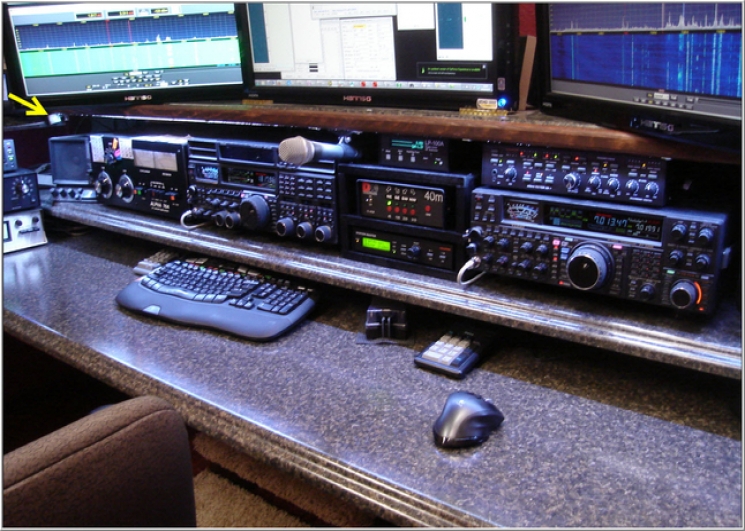Versatility and Auto-magical Action Combined Ceiling LightingThe room has can lights embedded in the ceiling. In addition one eyeball light is placed above and behind the operator position to light the gear face. The lights are positioned so that there is no reflection from the bench into the operator eyes (something I find fatiguing). 

In addition, there are a pair of daylight-colored high-output fluorescent fixtures. These are very useful for getting the room bright and is more appropriate for magazine browsing, etc. 
Motion Sensor and LED Light StripsJust over the top front of the rigs are LED lighting strips recessed into the bottom surface of the top shelf. The LED is tied into a motion sensor (yellow arrow) which detects activity in the shack. So walking into the shack will cause the LED lights to ramp on and turn on the shack PC monitors. 
The circuit is based on a version of the popular Arduino; in this case the Teensyduno v2.0 AT-MEGA 32 based board. The Teensyduno is a handy selection because the firmware provided with the Teensyduno emulates a USB keyboard without any coding required, and sample code had been published on the Internet for this motion-sensor-keyboard-tap application making the project very quick to get running. The motion sensor input it detected by the Teensyduno which in turn turns on the LED strip - and once per minute, taps the shift key to bring the PC monitors out of power save - or to remain active if they already are powered on. When the room is vacant, the LED strips are shut off after a couple of minutes, and the PC monitors go into a power save mode. [In fact it was the high heat production (300w per monitor) and resulting room temperature rise in the summer months that got me thinking about this project originally.] The LED strips are driven through a buffered relay set; a small board selected to minimize the amount of bench work required. There is a small 2N7000 FET between the Teensyduno and the relay - used as a way to isolate the two boards just in case I did something wrong and fried one of the two boards. The 2N7000 is not required. A recent addition is an IRFZ44Z HEXFET connected across the relays. The code uses a ramp up of duty cycle on one Teensyduno output to drive the FET, gradually ramping up the apparent LED brightness over about about 2 seconds. At that point, the relay is engaged and the FET disabled. The ON-resistance of the FET is low and the maximum FET heat dissipation is under 1W. The FET is mounted on a small heat sink so I did not need to worry about the FET while debugging the code; it's not really needed for the final code. 
|